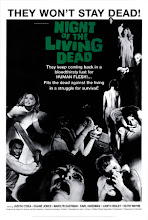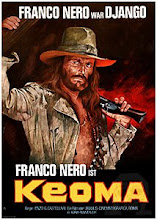 23rd November 2007: Steckler, Buchanan, Hall Jr Part 2!
23rd November 2007: Steckler, Buchanan, Hall Jr Part 2!
The Thrill Killers First is Ray Dennis Steckler’s follow-up feature to his 1963 Incredibly Strange Creatures Who Stopped Living And Became Mixed-Up Zombies. Taking his cues from Hitchcock’s Psycho (1960), Steckler tries his hand at the horror genre and fashions a no-budget shocker which, from the director of charming fluff like The Lemon Grove Kids Meet The Monsters (1965) and Rat Pfink A Boo Boo (1966), is surprisingly heavy on the shocks. If Steckler’s filmmaking career was running parallel with Arch Hall Sr and Jr’s – and there’s many crossover points, Wild Guitar notwithstanding – this is Steckler’s The Sadist (1963): filmed in stark black and white, grueling, consistently grim and just plain wrong.
However it’s from Steckler’s film universe, so his universal laws apply, right down to the casting of his regular hustlers: Titus Moede as a motorcycle cop, Atlas King, Gary Kent, not to mention Steckler’s then-wife Carolyn Brandt and Steckler himself. The unlikely named “Brick” Bardo (real name Joseph) plays Joe Saxon, perennial loser and would-be actor whose wife, Liz (real-life showgirl, gangster moll and would-be actress Liz Renay) accuses him of not living in the “real world” - wherever the hell THAT may be in Steckler’s bizarro universe. Liz, herself a former actress (the character, I mean), now finds herself bored, restless, and trapped in a mansion that’s starting to look decidedly soiled. Her husband decides to throw a party for some Hollywood phonies – and who should appear but The Thrill Killers’ producers Arch Hall Sr and George J. Morgan, arms around a pair of barely legal party hoppers, playing pie-eyed versions of their real selves. Talk about blurring the lines of reality even further.
Meanwhile, on the other side of Topanga Canyon, Steckler’s alter-ego “Cash Flagg” emerges from behind the camera to play the clearly deranged Mort “Mad Dog” Click, well into a serious killing spree as he shoots a passing motorist (Atlas King) and steals his station wagon. “People are no good!” he proclaims before stabbing a go-go dancer with a pair of scissors. It’s amazing that Steckler resurrected “Cash Flagg” as an afterthought to beef up the film’s running time, as he’s certainly its most memorable part. Surely the sight of Steckler’s iconic crew-cut skull perched on top of a heart of pure evil is up there with his hooded zombie in Incredibly Strange Creatures… as some of the most indelible images from Sixties low-budget Americana.
Back to Liz as drives to a diner run by her beatnik cousin to escape the tedium of her Hollywood hack husband. She narrowly misses regular customers and almost-weds Ron (Ron Burr) and Carol (Steckler’s then-wife Carolyn Brandt) who are checking out their dream house in the Canyon - but don’t get too fond of them, they don’t stick around for long. Also in the house are three escaped patients from a nearby asylum, and one of them - Herb Robins (Herbie), later seen chowing into a jar full of real wrigglers in Ted V. Mikels’ The Worm Eaters (1977) – has an axe. In every other Steckler film the three psychopaths would have been a trio of boobs being a poor man’s version of the Bowery Boys, but not here: the film’s not played for laughs, although there are some dark chuckles if you’re in the right frame of mind.
Three psychos with an axe, a screaming Liz Renay and a frantic Joe Schmoe who desperately wants to be a real-life action hero AND Herb’s brother “Mad Dog” shooting a cowboy and stealing a horse to gallop away from the cops – it all spirals into a mad, twisting game of cat and mouse and a delirious chase along the side of Topanga Canyon. It’s more than a B-film - it’s John Cassavettes with a pulp sensibility, deeply self-referential and filled with personal motifs and visual fetishes. Don’t forget just how good the film looks; there’s real grime in each black and white frame, shot almost entirely in daylight and yet filled with shadows and shades of grey, making it just that more genuinely unnerving.
Weird, intense, and unlike any other film of its time (with the possible exception of The Sadist), we’re proud to present another odd find from the netherworld of Ray Dennis Steckler: the 1964 The Thrill Killers.
Zontar The Thing From Venus
 Now to our second film from Texan auteur Larry Buchanan, and second in Larry Buchanan’s monumental effort to make eight films over a two year period for American International Pictures. Like the other TV titles in what would become known as the “Azalea Films” (after Buchanan’s production company), a good chunk of the $25,000 budget would have gone on paying their single “name” actor. For Zontar The Thing From Venus, a rough-as-guts remake of Roger Corman’s cool Cold War paranoia quickie It Conquered The World (1956), Buchanan hired John Agar, a B-identity to be sure, but so memorable in The Brain From Planet Arous (1957). The rest of the cast is filled out by underpaid stock players from Azalea’s repertory company.
Now to our second film from Texan auteur Larry Buchanan, and second in Larry Buchanan’s monumental effort to make eight films over a two year period for American International Pictures. Like the other TV titles in what would become known as the “Azalea Films” (after Buchanan’s production company), a good chunk of the $25,000 budget would have gone on paying their single “name” actor. For Zontar The Thing From Venus, a rough-as-guts remake of Roger Corman’s cool Cold War paranoia quickie It Conquered The World (1956), Buchanan hired John Agar, a B-identity to be sure, but so memorable in The Brain From Planet Arous (1957). The rest of the cast is filled out by underpaid stock players from Azalea’s repertory company.
 Set in a space surveillance station, its limited resources means there’s lots of shots of scientists standing in rooms twiddling knobs and speaking in “Scientese”. Speaking of “Scientese”, our anti-hero Keith Ritchie (Anthony Huston) is full of it – he invites his friend and co-worker Dr Curt Taylor (Agar) and his wife to dinner, only to confide he’s been receiving instructions from a being on Venus with an untranslatable name that roughly sounds like “Zontar”. To prove the point, Keith shows his guests a closet full of transistors making sounds like frying eggs, which he believes is Zontar communicating with him by “hyperspace hypnotism”. As far as Curt can see, his friend looks like a madman yelling at his radio, but then one of Earth’s satellites are sabotaged and goes missing. Could it be Zontar’s on the way? And could his true mission on Earth be… to take over the World?
Set in a space surveillance station, its limited resources means there’s lots of shots of scientists standing in rooms twiddling knobs and speaking in “Scientese”. Speaking of “Scientese”, our anti-hero Keith Ritchie (Anthony Huston) is full of it – he invites his friend and co-worker Dr Curt Taylor (Agar) and his wife to dinner, only to confide he’s been receiving instructions from a being on Venus with an untranslatable name that roughly sounds like “Zontar”. To prove the point, Keith shows his guests a closet full of transistors making sounds like frying eggs, which he believes is Zontar communicating with him by “hyperspace hypnotism”. As far as Curt can see, his friend looks like a madman yelling at his radio, but then one of Earth’s satellites are sabotaged and goes missing. Could it be Zontar’s on the way? And could his true mission on Earth be… to take over the World?
 Soon it’s like a shoestring Apocalypse - cars won’t start, taps won’t turn on, everything is “de-energized” leading to panic on the streets (or one street at least). Keith becomes drunk with power, arrogantly believing Zontar is the world’s saviour, and he’s got a front row seat to witness mankind’s transformation. This is what happens to the nerdy kid at school who’s made fun of for being a brainiac – your only friend is a fascist from Venus who holes himself up in an underground cavern for most of the film’s eighty minutes. At first, all we see of Zontar are weird flying creatures called “injectapods” – a cross between an owl and a bat, secreting a controlling device on the back of their victims’ necks. Keith’s wife finally has enough of her husband’s Goebbels trip and confronts Zontar face to face. And what a face! Zontar’s brief appearance can only be described as a three-eyed turd with wings. And that’s being kind.
Soon it’s like a shoestring Apocalypse - cars won’t start, taps won’t turn on, everything is “de-energized” leading to panic on the streets (or one street at least). Keith becomes drunk with power, arrogantly believing Zontar is the world’s saviour, and he’s got a front row seat to witness mankind’s transformation. This is what happens to the nerdy kid at school who’s made fun of for being a brainiac – your only friend is a fascist from Venus who holes himself up in an underground cavern for most of the film’s eighty minutes. At first, all we see of Zontar are weird flying creatures called “injectapods” – a cross between an owl and a bat, secreting a controlling device on the back of their victims’ necks. Keith’s wife finally has enough of her husband’s Goebbels trip and confronts Zontar face to face. And what a face! Zontar’s brief appearance can only be described as a three-eyed turd with wings. And that’s being kind.
 Zontar The Thing From Venus is a low-brow cheapie – in fact, it’s about as low as it can go – and yet it sets its sights high. It’s a comment on fascism, communism, cultism or occultism, you name the “ism” and its dehumanizing effects, and much more. According to Keith’s early monologue, alien intelligence is watching us pathetic Earthlings to protect us from ourselves, as we’re not advanced enough to join the Planetary Federation. It’s a weatherbeaten idea that’s trotted out in UFO conspiracy and New Age circles to this day, and it still sounds like a cheap paperback plot device. When will these New Agers learn? I give you pathetic Earthlings another Z-grade effort from the king of paperback conspiracy films – that’s Z for Zontar The Thing From Venus
Zontar The Thing From Venus is a low-brow cheapie – in fact, it’s about as low as it can go – and yet it sets its sights high. It’s a comment on fascism, communism, cultism or occultism, you name the “ism” and its dehumanizing effects, and much more. According to Keith’s early monologue, alien intelligence is watching us pathetic Earthlings to protect us from ourselves, as we’re not advanced enough to join the Planetary Federation. It’s a weatherbeaten idea that’s trotted out in UFO conspiracy and New Age circles to this day, and it still sounds like a cheap paperback plot device. When will these New Agers learn? I give you pathetic Earthlings another Z-grade effort from the king of paperback conspiracy films – that’s Z for Zontar The Thing From Venus
Deadwood '76
And now to the final of our three films tonight, and the last of six films in our Arch Hall Junior season. Arch-baby, the awkward matinee pseudo-idol manufactured by his dear old dad Arch Hall Senior, never really had his heart in his work and just wanted to be a pilot, which is what he does to this day. What he did leave was a strange filmic legacy via his father’s company Fairway Pictures: six features, each a different genre (sci fi, comedy, juvenile delinquent, teen rock movie), and each an odd little duck with their own unique personalities. Deadwood ’76 is Fairway’s western, and you can just tell Arch Hall Sr, former stuntman and bit player, was itchin’ to get back to the Old West. The result is a film that seems twenty years too late: a VERY straight western, and a little preachy at that too. By playing it too straight, it strangles the very essence that makes films like Eegah! and Wild Guitar (both 1962) so enjoyable.
It’s 1876 and the Gold Rush is sending every man and his mule poring into the West since, as the old cliché goes (and God knows, it’s in the script), “there’s gold in them hills”. Arch is out of place as ever, his blonde mane crushed under a Stetson and with a chin that looks like it’s taken a slug from a .45. As Billy May, a young upstart gunfighter, he teams up with Tennessee, a prospector with a wagon load of cats bound for Deadwood, a lawless town run by bad men – and women. The whole town’s waiting on a rumoured showdown between Wild Bill Hickok and Billy The Kid – hell, they’re even betting their pension funds on it. Arch is mistaken for The Kid, and in a flush of youthful arrogance he doesn’t bother to correct them. When the local cathouse owner Fancy and his partner-in-crime, the brassy sassy Poker Kate (Liz Renay hiding behind the “Melissa Morgan” moniker – for tax reasons, I can only surmise), find out the truth, they keep their mouths shut and wait for Wild Bill to bring Billy down.
He and Tenessee go into the mining business but Billy’s captured by “Injuns” and taken to their camp where he sees his paw. His actual paw, as well - Arch Sr as “William Watters”, playing Billy’s father Boone May, a shabby confederate hiding amongst the Sioux, madder than a cut snake that’s been left to fry in the sun. More potbellied and grizzled than ever, Boone is still fighting the civil war and waiting for the Sioux to join him in the uprising against the damned Yankees. An Indian princess named Little Bird, daughter of chief Red Cloud, starts making goo-goo eyes at Billy and wants to come with him, but Billy knows his road is long and winding and paved with thorns. “Yuh jes’ can’t,” he says, and makes her cry. What a boob.
Heading back into town, he finds there’s three men who want him dead: local thug Sam Bass, whose men Billy took down; Wild Bill hisself; and a 15 year old would-be gunslinger who calls himself “The Badlands Kid”, and wants to go down in history as boy who shot Billy - May, the Kid, whoever the hell he is. In fact the whole town is itchin’ for a lynchin’, as we’re reminded by the ever-present “Ballad of Deadwood” which pops up like an unwanted Greek Chorus every five minutes to lament on the action.
“Dead Wood” is an appropriate name – shame it doesn’t go for 76 minutes. At over the hour and a half mark, it’s obvious Arch Sr is trying to get more bang for his buck. With acting as wooden as the hitching posts the horses are tied to, and a script littered with “varmints” and lines like “the only good injun is a dead injun”, and other assorted chestnuts – all that’s missing is a “dagnabbit” – it’s a less-than-memorable career capper for Arch Baby. Still, we’ve had a good run out of Arch, and I feel that we all get some kind of closure from the wild and woolly western antics of Deadwood ’76.
 23rd November 2007: Steckler, Buchanan, Hall Jr Part 2!
23rd November 2007: Steckler, Buchanan, Hall Jr Part 2! Now to our second film from Texan auteur Larry Buchanan, and second in Larry Buchanan’s monumental effort to make eight films over a two year period for American International Pictures. Like the other TV titles in what would become known as the “Azalea Films” (after Buchanan’s production company), a good chunk of the $25,000 budget would have gone on paying their single “name” actor. For Zontar The Thing From Venus, a rough-as-guts remake of Roger Corman’s cool Cold War paranoia quickie It Conquered The World (1956), Buchanan hired John Agar, a B-identity to be sure, but so memorable in The Brain From Planet Arous (1957). The rest of the cast is filled out by underpaid stock players from Azalea’s repertory company.
Now to our second film from Texan auteur Larry Buchanan, and second in Larry Buchanan’s monumental effort to make eight films over a two year period for American International Pictures. Like the other TV titles in what would become known as the “Azalea Films” (after Buchanan’s production company), a good chunk of the $25,000 budget would have gone on paying their single “name” actor. For Zontar The Thing From Venus, a rough-as-guts remake of Roger Corman’s cool Cold War paranoia quickie It Conquered The World (1956), Buchanan hired John Agar, a B-identity to be sure, but so memorable in The Brain From Planet Arous (1957). The rest of the cast is filled out by underpaid stock players from Azalea’s repertory company.  Set in a space surveillance station, its limited resources means there’s lots of shots of scientists standing in rooms twiddling knobs and speaking in “Scientese”. Speaking of “Scientese”, our anti-hero Keith Ritchie (Anthony Huston) is full of it – he invites his friend and co-worker Dr Curt Taylor (Agar) and his wife to dinner, only to confide he’s been receiving instructions from a being on Venus with an untranslatable name that roughly sounds like “Zontar”. To prove the point, Keith shows his guests a closet full of transistors making sounds like frying eggs, which he believes is Zontar communicating with him by “hyperspace hypnotism”. As far as Curt can see, his friend looks like a madman yelling at his radio, but then one of Earth’s satellites are sabotaged and goes missing. Could it be Zontar’s on the way? And could his true mission on Earth be… to take over the World?
Set in a space surveillance station, its limited resources means there’s lots of shots of scientists standing in rooms twiddling knobs and speaking in “Scientese”. Speaking of “Scientese”, our anti-hero Keith Ritchie (Anthony Huston) is full of it – he invites his friend and co-worker Dr Curt Taylor (Agar) and his wife to dinner, only to confide he’s been receiving instructions from a being on Venus with an untranslatable name that roughly sounds like “Zontar”. To prove the point, Keith shows his guests a closet full of transistors making sounds like frying eggs, which he believes is Zontar communicating with him by “hyperspace hypnotism”. As far as Curt can see, his friend looks like a madman yelling at his radio, but then one of Earth’s satellites are sabotaged and goes missing. Could it be Zontar’s on the way? And could his true mission on Earth be… to take over the World? Soon it’s like a shoestring Apocalypse - cars won’t start, taps won’t turn on, everything is “de-energized” leading to panic on the streets (or one street at least). Keith becomes drunk with power, arrogantly believing Zontar is the world’s saviour, and he’s got a front row seat to witness mankind’s transformation. This is what happens to the nerdy kid at school who’s made fun of for being a brainiac – your only friend is a fascist from Venus who holes himself up in an underground cavern for most of the film’s eighty minutes. At first, all we see of Zontar are weird flying creatures called “injectapods” – a cross between an owl and a bat, secreting a controlling device on the back of their victims’ necks. Keith’s wife finally has enough of her husband’s Goebbels trip and confronts Zontar face to face. And what a face! Zontar’s brief appearance can only be described as a three-eyed turd with wings. And that’s being kind.
Soon it’s like a shoestring Apocalypse - cars won’t start, taps won’t turn on, everything is “de-energized” leading to panic on the streets (or one street at least). Keith becomes drunk with power, arrogantly believing Zontar is the world’s saviour, and he’s got a front row seat to witness mankind’s transformation. This is what happens to the nerdy kid at school who’s made fun of for being a brainiac – your only friend is a fascist from Venus who holes himself up in an underground cavern for most of the film’s eighty minutes. At first, all we see of Zontar are weird flying creatures called “injectapods” – a cross between an owl and a bat, secreting a controlling device on the back of their victims’ necks. Keith’s wife finally has enough of her husband’s Goebbels trip and confronts Zontar face to face. And what a face! Zontar’s brief appearance can only be described as a three-eyed turd with wings. And that’s being kind. Zontar The Thing From Venus is a low-brow cheapie – in fact, it’s about as low as it can go – and yet it sets its sights high. It’s a comment on fascism, communism, cultism or occultism, you name the “ism” and its dehumanizing effects, and much more. According to Keith’s early monologue, alien intelligence is watching us pathetic Earthlings to protect us from ourselves, as we’re not advanced enough to join the Planetary Federation. It’s a weatherbeaten idea that’s trotted out in UFO conspiracy and New Age circles to this day, and it still sounds like a cheap paperback plot device. When will these New Agers learn? I give you pathetic Earthlings another Z-grade effort from the king of paperback conspiracy films – that’s Z for Zontar The Thing From Venus
Zontar The Thing From Venus is a low-brow cheapie – in fact, it’s about as low as it can go – and yet it sets its sights high. It’s a comment on fascism, communism, cultism or occultism, you name the “ism” and its dehumanizing effects, and much more. According to Keith’s early monologue, alien intelligence is watching us pathetic Earthlings to protect us from ourselves, as we’re not advanced enough to join the Planetary Federation. It’s a weatherbeaten idea that’s trotted out in UFO conspiracy and New Age circles to this day, and it still sounds like a cheap paperback plot device. When will these New Agers learn? I give you pathetic Earthlings another Z-grade effort from the king of paperback conspiracy films – that’s Z for Zontar The Thing From Venus




















































































No comments:
Post a Comment